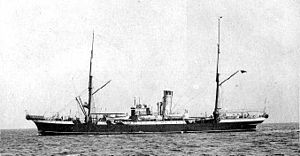CS Mackay-Bennett

CS Mackay-Bennett around 1900
|
|
| History | |
|---|---|
| Name: | Mackay-Bennett |
| Namesake: | John Mackay & Gordon Bennett |
| Operator: | Commercial Cable Company |
| Port of registry: | London, England |
| Builder: | John Elder & Co., Glasgow |
| Launched: | September 1884 |
| In service: | 1884 |
| Out of service: | May 1922 |
| Homeport: | Halifax, Nova Scotia / Plymouth, England |
| Fate: |
|
| General characteristics | |
| Type: | Cable ship |
| Tonnage: | 2,000 gross register tons (GRT) |
| Length: | |
| Beam: | 40 ft (12 m) |
| Depth: | 24 ft 6 in (7.47 m) moulded |
| Propulsion: | |
CS Mackay-Bennett was a cable repair ship registered in London, England, owned by the Commercial Cable Company. The ship became infamously known for being the ship that recovered the majority of the victims of the Titanic sinking.
The ship was commissioned from then noted River Clyde-based warship builders John Elder & Co., who incorporated a number of new and then original features into a cable ship. One of the first ships built from steel, she had a relatively deep keel design to: accommodate as much cable as possible; keep the ship stable in the Atlantic Ocean swells; and yet a design which was also very hydrodynamic to keep her fuel efficient and fast in operation. The hull design included bilge keels to keep her stable, and she had two rudders, one fore and one aft, to maximize manoeuvrability.
Named after the two founders of her owners, the sailors who served aboard her pronounced the name "Macky-Bennett." Mainly based out of Halifax, Nova Scotia, where she first arrived in March 1885, she was also often used for operations on the European side of the Atlantic, based out of Plymouth, England. The Canadian author Thomas Raddall worked as wireless operator aboard Mackay-Bennett and based some short stories on his experiences aboard.
In addition to carrying out numerous difficult cable repairs, many during times of wartime danger, due to the nature of her work and resultant position in the Atlantic, Mackay-Bennett performed many rescues. Typical was the rescue of the crew of the sinking schooner Caledonia on February 12, 1912.
In April 1912, whilst working on maintaining the France-to-Canada communications cable, the ship became famous as the first vessel contracted by the White Star Line to carry out the difficult task of recovering the bodies left floating in the North Atlantic, after the Titanic disaster. After returning to port in Halifax, Nova Scotia and clearing out her cable stores, her captain Frederick H. Larnder took on board above her normal supplies. Specialized personnel and supplies taken on board for the assignment included:
...
Wikipedia
